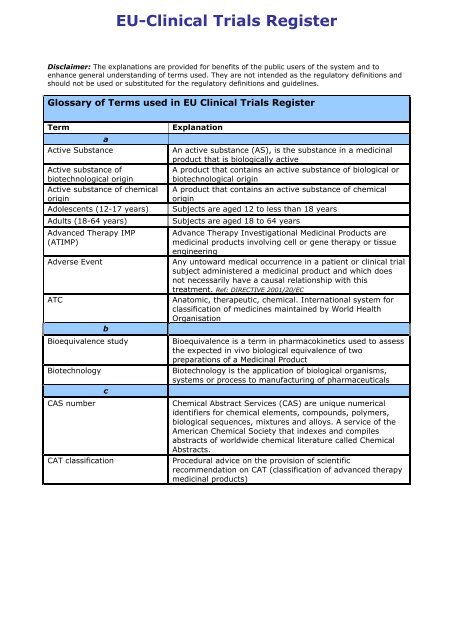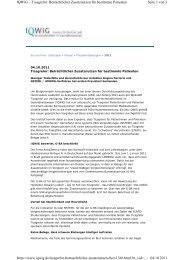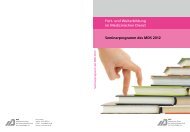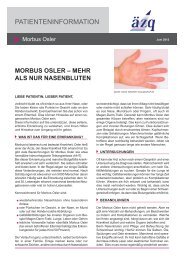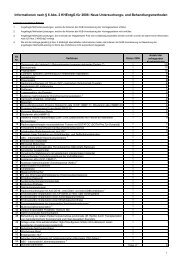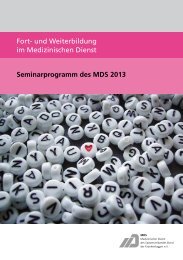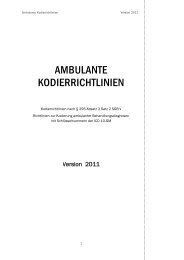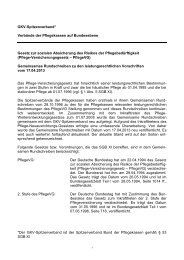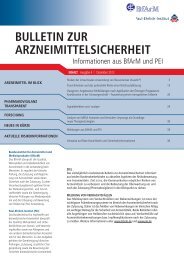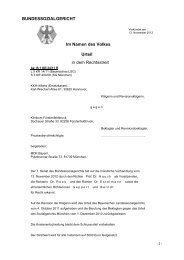EU-Clinical Trials Register - Sindbad
EU-Clinical Trials Register - Sindbad
EU-Clinical Trials Register - Sindbad
You also want an ePaper? Increase the reach of your titles
YUMPU automatically turns print PDFs into web optimized ePapers that Google loves.
<strong>EU</strong>-<strong>Clinical</strong> <strong>Trials</strong> <strong>Register</strong><br />
Disclaimer: The explanations are provided for benefits of the public users of the system and to<br />
enhance general understanding of terms used. They are not intended as the regulatory definitions and<br />
should not be used or substituted for the regulatory definitions and guidelines.<br />
Glossary of Terms used in <strong>EU</strong> <strong>Clinical</strong> <strong>Trials</strong> <strong>Register</strong><br />
Term<br />
a<br />
Active Substance<br />
Active substance of<br />
biotechnological origin<br />
Active substance of chemical<br />
origin<br />
Adolescents (12-17 years)<br />
Adults (18-64 years)<br />
Advanced Therapy IMP<br />
(ATIMP)<br />
Adverse Event<br />
ATC<br />
b<br />
Bioequivalence study<br />
Biotechnology<br />
CAS number<br />
c<br />
CAT classification<br />
Explanation<br />
An active substance (AS), is the substance in a medicinal<br />
product that is biologically active<br />
A product that contains an active substance of biological or<br />
biotechnological origin<br />
A product that contains an active substance of chemical<br />
origin<br />
Subjects are aged 12 to less than 18 years<br />
Subjects are aged 18 to 64 years<br />
Advance Therapy Investigational Medicinal Products are<br />
medicinal products involving cell or gene therapy or tissue<br />
engineering<br />
Any untoward medical occurrence in a patient or clinical trial<br />
subject administered a medicinal product and which does<br />
not necessarily have a causal relationship with this<br />
treatment. Ref: DIRECTIVE 2001/20/EC<br />
Anatomic, therapeutic, chemical. International system for<br />
classification of medicines maintained by World Health<br />
Organisation<br />
Bioequivalence is a term in pharmacokinetics used to assess<br />
the expected in vivo biological equivalence of two<br />
preparations of a Medicinal Product<br />
Biotechnology is the application of biological organisms,<br />
systems or process to manufacturing of pharmaceuticals<br />
Chemical Abstract Services (CAS) are unique numerical<br />
identifiers for chemical elements, compounds, polymers,<br />
biological sequences, mixtures and alloys. A service of the<br />
American Chemical Society that indexes and compiles<br />
abstracts of worldwide chemical literature called Chemical<br />
Abstracts.<br />
Procedural advice on the provision of scientific<br />
recommendation on CAT (classification of advanced therapy<br />
medicinal products)
Glossary of Terms used in <strong>EU</strong> <strong>Clinical</strong> <strong>Trials</strong> <strong>Register</strong><br />
Term<br />
CE mark<br />
Classification code (MedDRA)<br />
<strong>Clinical</strong> Trial (CT)<br />
Combination ATIMP<br />
Comparator<br />
Competent Authority (CA)/<br />
National Competent Authority<br />
(NCA)<br />
Also referred as National<br />
Medicine Regulatory<br />
Authorities<br />
Concentration unit<br />
Controlled<br />
Countries in which trial sites<br />
are planned<br />
Country which granted the<br />
Marketing Authorisation<br />
Cross over<br />
Current sponsor code<br />
Explanation<br />
European conformity Marking: A mandatory European<br />
marking for products falling under one of the New Approach<br />
Directives (including medical devices, but excluding<br />
cosmetics, chemicals, pharmaceuticals, foodstuffs) to<br />
indicate conformity with the health and safety requirements<br />
set out in European Directive<br />
An eight digit unique numeric code assigned to a MedDRA<br />
term. The code is non-expressive and is intended to fulfill a<br />
data field in various electronic submission types<br />
Any investigation in human subjects intended to discover or<br />
verify the clinical, pharmacological and/or other<br />
pharmacodynamic effects of one or more investigational<br />
medicinal product(s), and/or to identify any adverse<br />
reactions to one or more investigational medicinal<br />
product(s) and/or to study absorption, distribution,<br />
metabolism and excretion of one or more investigational<br />
medicinal product(s) with the object of ascertaining its<br />
(their) safety and/or efficacy. Ref: DIRECTIVE 2001/20/EC<br />
An ATIMP (Advanced Therapy Investigational Medicinal<br />
Product) involving a medical device<br />
An investigational or marketed product (i.e. active control)<br />
or placebo, used as a reference in a clinical trial<br />
A regulatory agency in an <strong>EU</strong> Member State or for medical<br />
devices, a Competent Authority is the organization with the<br />
authority to act on behalf of the government of a Member<br />
State to ensure that all medical devices meet the essential<br />
requirements laid down in the Directives prior to marketing<br />
authorisation<br />
The unit of measurement used for the concentration of the<br />
active substance<br />
In a controlled trial, the tested product is compared to a<br />
reference treatment. The reference treatment can be, for<br />
example, a placebo, a product known to be effective, a<br />
surgical procedure, or a different dose of the same product.<br />
Country(s) where clinical trials are planned to be conducted<br />
Name of the country where the holder was granted the<br />
Marketing Authorisation of the actual IMP to be used in the<br />
clinical trial in the member state concerned by the<br />
application.<br />
Comparison of two (or more) treatments in which patients<br />
are switched to the alternative treatment after a specified<br />
period of time<br />
The current code in use by the sponsor for an active<br />
substance<br />
EMA/534108/2010 Page 2/12
Glossary of Terms used in <strong>EU</strong> <strong>Clinical</strong> <strong>Trials</strong> <strong>Register</strong><br />
Term<br />
d<br />
Data Monitoring Committee<br />
Date of Competent Authority<br />
Decision<br />
Date of Ethics Committee<br />
Opinion<br />
Date of the global end of the<br />
trial<br />
Description of the IMP<br />
Diagnosis<br />
Dose response<br />
Double blind<br />
EEA<br />
Efficacy<br />
e<br />
Elderly (>=65 years)<br />
EMA<br />
EMA Decision number of PIP<br />
Emergency situation<br />
Ethics Committee (EC)<br />
<strong>EU</strong><br />
Explanation<br />
A Data Monitoring Committee is a group of independent<br />
experts external to a study assessing the progress, safety<br />
data and, if needed critical efficacy endpoints of a clinical<br />
study.<br />
This is the date on which the National Competent Authority<br />
Decision was made on clinical trial<br />
This is the date on which the Independent Ethics Committee<br />
Opinion was given on clinical trial<br />
This is the date on which the trial is ended in all countries<br />
The physical description of the product (e.g. white tablet,<br />
solution)<br />
The condition being studied<br />
The dose-response describes the change in effect caused by<br />
differing doses to a Medicinal Product after a certain<br />
exposure time. This may apply to individuals, or to<br />
populations.<br />
A trial where the investigators and the subjects included in<br />
the trial (healthy volunteers or patients) don’t know which<br />
treatment is given<br />
European Economic Area<br />
A measure of whether the medicinal product has its<br />
intended effect<br />
Subjects are aged 65 years or more<br />
European Medicines Agency<br />
European Medicines Agency's decision number for the<br />
Paediatric Investigation Plan (PIP)<br />
Situation where urgent care is needed for the patient and<br />
this involves enrolment in the trial (for example: head<br />
injury).<br />
Independent reviewing body that considers and<br />
approves/disapproves biomedical research involving human<br />
subjects. Ethics Committee approval is required for each<br />
clinical study protocol and Principal Investigator prior to<br />
study initiation<br />
European Union<br />
EMA/534108/2010 Page 3/12
Glossary of Terms used in <strong>EU</strong> <strong>Clinical</strong> <strong>Trials</strong> <strong>Register</strong><br />
Term<br />
EudraCT<br />
EudraCT Number<br />
EV Product Code<br />
EV Substance Code<br />
Extractive medicinal product<br />
First human administration<br />
Full title of the trial<br />
Functional name of contact<br />
point<br />
g<br />
f<br />
Gene therapy medical product<br />
GMO<br />
h<br />
Healthy volunteers<br />
Herbal medicinal product<br />
Homeopathic medicinal<br />
product<br />
Explanation<br />
EudraCT (European Union Drug Regulating Authorities<br />
<strong>Clinical</strong> <strong>Trials</strong>) is the European <strong>Clinical</strong> <strong>Trials</strong> Database of all<br />
interventional clinical trials of medicinal products<br />
commencing in the European Union from 1 May 2004<br />
onwards. The EudraCT database has been established in<br />
accordance with Directive 2001/20/EC<br />
When registered, each trial is issued with a unique EudraCT<br />
number, which identifies the protocol and trial throughout<br />
its lifespan<br />
Marketed Product's EudraVigilance Number<br />
Active Substance's EudraVigilance Substance Code<br />
A medicinal product derived from human tissue such as<br />
blood or plasma<br />
Conducting the first dose in human phase I clinical trial<br />
The title as specified in the study protocol and other<br />
documents submitted as part of the <strong>Clinical</strong> Trial<br />
Application.<br />
The point of contact for further information on the trial (e.g.<br />
“<strong>Clinical</strong> Trial Information Desk”)<br />
Product aimed at the transfer of a prophylactic, diagnostic<br />
or therapeutic gene to human and its subsequent expression<br />
in vivo<br />
A genetically modified organism (GMO) or genetically<br />
engineered organism (GEO) is an organism whose genetic<br />
material has been altered using genetic engineering<br />
techniques<br />
<strong>Clinical</strong> trial includes subjects in good health<br />
Any medicinal product exclusively containing as active<br />
ingredients one or more herbal substances or preparations.<br />
adapted from Dir 83/2001<br />
Homeopathic medicinal products are medicinal products<br />
based on a dilute solution of raw material from the plant,<br />
animal or mineral kingdoms.<br />
EMA/534108/2010 Page 4/12
Glossary of Terms used in <strong>EU</strong> <strong>Clinical</strong> <strong>Trials</strong> <strong>Register</strong><br />
Term<br />
Human pharmacology (Phase<br />
I)<br />
IEC Opinion of amendment<br />
Immunological medicinal<br />
product<br />
IMP<br />
i<br />
IMP to be used in the trial has<br />
a marketing authorisation<br />
Interventional trial<br />
In the whole clinical trial<br />
In Utero<br />
Investigator<br />
In Vivo<br />
Infants and toddlers (28<br />
days-23 months)<br />
Explanation<br />
Human pharmacology (Phase I) trials are the first stage of<br />
testing in human subjects, generally comprising a small<br />
group of healthy volunteers. This phase includes trials<br />
designed to assess the safety (pharmacovigilance),<br />
tolerability, pharmacokinetics, and pharmacodynamics of a<br />
drug<br />
Independent Ethics Committee opinion<br />
Any medicinal product consisting of vaccines, toxins, serums<br />
or allergen products used to produce an immunological<br />
response<br />
(Investigational Medicinal Product) A pharmaceutical form of<br />
an active substance or placebo being tested or used as a<br />
reference in a clinical trial, including products already with a<br />
marketing authorisation but used or assembled in a different<br />
way from the authorised form, or when used for an<br />
unauthorised indication, or when used to gain further<br />
information about the authorised form<br />
Investigational Medicinal Product has a Marketing<br />
Authorisation in the Member State concerned by this<br />
application<br />
An interventional trial sets up to discover or verify the<br />
effects of one or more investigational medicinal product(s)<br />
(IMP), to ascertain its (their) safety and/or efficacy. The<br />
assignment of the patient to a particular therapeutic<br />
strategy is decided in advance by a trial protocol. The way<br />
the IMP(s) are used, and the way the patients are selected<br />
for the trial and followed up are not as per current practice,<br />
and the data from the trial are systematically analysed<br />
Details of the planned number of subjects in the entire<br />
world to be included<br />
Subjects are unborn infants, still in the womb.<br />
A doctor or a person following a profession agreed in the<br />
Member State for investigations because of the scientific<br />
background and the experience in patient care it requires.<br />
The investigator is responsible for the conduct of a clinical<br />
trial at a trial site. If a trial is conducted by a team of<br />
individuals at a trial site, the investigator is the leader<br />
responsible for the team and may be called the principal<br />
investigator<br />
Within the living body (animal/man). A phenomenon that<br />
occurs in real life, as opposed to in the laboratory ("in<br />
vitro")<br />
Subjects are aged 28 days to less than 2 years<br />
EMA/534108/2010 Page 5/12
Glossary of Terms used in <strong>EU</strong> <strong>Clinical</strong> <strong>Trials</strong> <strong>Register</strong><br />
Term<br />
INN - Proposed INN<br />
ISRCTN number<br />
IVRS<br />
j<br />
Explanation<br />
The International Non-proprietary name for an active<br />
substance.<br />
International Standard Randomised Controlled Trial Number<br />
is used for the identification of clinical trials worldwide. The<br />
randomly generated, eight-digit ISRCTN is unique to a<br />
registered trial at current controlled trials, thereby ensuring<br />
that the trial can be simply and unambiguously tracked<br />
throughout its lifecycle from initial protocol to results<br />
publication<br />
Interactive Voice Response System: commonly used for<br />
randomisation of treatment and controlling the shipment of<br />
stock of product.<br />
k<br />
l<br />
Legal Representative of<br />
Sponsor<br />
m<br />
Main objective of the trial<br />
Marketing Authorisation<br />
Marketing Authorisation<br />
Holder (MAH)<br />
MedDRA Classification<br />
MedDRA Level<br />
Medical condition in easily<br />
understood language<br />
Medical condition(s)<br />
investigated<br />
Multiple Member States<br />
An individual, company, institution, or organisation<br />
authorised to act on behalf of the sponsor of a clinical trial.<br />
Must be based in the <strong>EU</strong> or the EEA, which includes Iceland,<br />
Norway, and Liechtenstein.<br />
A description of the main objectives of the trial<br />
The approval granted by the Regulatory Authority to market<br />
a specific product in a particular country<br />
The company named on the Marketing Authorisation for a<br />
specific product in a particular country<br />
MedDRA (Medical Dictionary for Regulatory Activities) - is a<br />
medical terminology used to classify adverse event<br />
information associated with the use of biopharmaceuticals<br />
and other medical products (e.g., medical devices and<br />
vaccines)<br />
Key to MedDRA hierarchical levels (highest to lowest) SOC<br />
(System Organ Class) HLGT (High Level Group Term) HLT<br />
(High Level Term) PT (Preferred Term) LLT (Lowest Level<br />
Term)<br />
A description of the medical condition being studied in nonmedical<br />
language<br />
Description of intended indication for the product under<br />
development<br />
This is where the trial will be conducted in more than one<br />
Member State of the European Economic Area<br />
EMA/534108/2010 Page 6/12
Glossary of Terms used in <strong>EU</strong> <strong>Clinical</strong> <strong>Trials</strong> <strong>Register</strong><br />
Term<br />
Multiple sites in the Member<br />
State concerned<br />
Multinational trial<br />
n<br />
Name of organisation<br />
Name or abbreviated title of<br />
the trial<br />
Newborns (0-27 days)<br />
Number of sites anticipated in<br />
Member State concerned<br />
Number of sites anticipated in<br />
the EEA<br />
Number of sites anticipated<br />
outside of the EEA<br />
Number of treatment arms in<br />
the trial<br />
Nursing women<br />
o<br />
Objective of the trial<br />
Open Trial<br />
Orphan drug<br />
Orphan drug designation<br />
number<br />
Other descriptive name<br />
Explanation<br />
A trial is conducted in multiple sites in the concerned<br />
Member State.<br />
A multinational research trial is a clinical trial conducted at<br />
more than one country or multiple countries at the same<br />
time<br />
Name of individual, company, institution or organisation<br />
which takes responsibility for the initiation, management<br />
and/or financing of the clinical trial<br />
A shortened title or description of the clinical trial<br />
Subjects are newborn babies from birth to less than 28 days<br />
of age.<br />
This is number of sites in the Member State concerned<br />
where the trial will take place<br />
Number of investigator sites in the European Economic Area<br />
where the trial is planned to take place<br />
Number of investigator sites outside the European Economic<br />
Area where the trial is planned to take place<br />
Any of the treatment groups in a randomized trial. Most<br />
randomized trials have two "arms," but some have three<br />
"arms," or even more<br />
<strong>Clinical</strong> trial includes women subjects who are breastfeeding<br />
The goal intended to be attained by the <strong>Clinical</strong> Trial<br />
A Trial where the investigators and the subjects know which<br />
treatment is actually given<br />
An orphan drug is a pharmaceutical agent that has been<br />
developed specifically to treat a rare medical condition, the<br />
condition itself being referred to as an orphan disease. A<br />
drug for the treatment of a rare disease (affecting fewer<br />
than 200,000 people in the US or fewer than 5 in every<br />
10,000 individuals in the <strong>EU</strong>) or for a disease not likely to<br />
generate sufficient profit to justify Research and<br />
Development costs<br />
Designation of orphan drug status to drugs that are in the<br />
process of development for the treatment of rare diseases.<br />
Any other descriptive name for an active substance<br />
EMA/534108/2010 Page 7/12
Glossary of Terms used in <strong>EU</strong> <strong>Clinical</strong> <strong>Trials</strong> <strong>Register</strong><br />
Term<br />
Parallel group<br />
Paediatric Investigation Plan<br />
(PIP)<br />
Patients<br />
p<br />
Pharmaceutical form<br />
Pharmacodynamic<br />
Pharmacoeconomic<br />
Pharmacogenetic<br />
Pharmacogenomic<br />
Pharmacokinetic<br />
Phase I<br />
Phase II<br />
Phase III<br />
Explanation<br />
A trial in which two or more treatments are evaluated<br />
concurrently in separate groups of patients.<br />
Document upon which the development and authorisation of<br />
medicinal products for the paediatric population is based. It<br />
is presented by an applicant early during the development<br />
of a product to the EMA Paediatric Committee in order to<br />
agree a paediatric development plan.<br />
<strong>Clinical</strong> Trial includes subjects, who are currently patients,<br />
and can also include healthy volunteers.<br />
A dosage form is the physical form of a dose of medication,<br />
such as a capsule or injection. The route of administration is<br />
dependent on the dosage.<br />
Pharmacodynamics is the exploration of what the Medicinal<br />
Product does to the body.<br />
Pharmacoeconomics refers to the scientific discipline that<br />
compares the value of one pharmaceutical drug or drug<br />
therapy to another.<br />
Pharmacogenetics is generally regarded as the study or<br />
clinical trial of genetic variation that gives rise to differing<br />
response to drugs.<br />
Pharmacogenomics is the broader application of genomic<br />
technologies to new drug discovery and further<br />
characterization of older drugs.<br />
Pharmacokinetics is the exploration of what the body does<br />
to a Medicinal Product.<br />
Phase I is the first stage of a clinical trial. It is to ensure a<br />
treatment is safe for people to take, rather than to try to<br />
treat a condition. These trials are very small, (typically<br />
around 30 people), and usually involve healthy volunteers<br />
or sometimes patients. Ref: http://www.mssociety.org.uk<br />
The second phase in clinical trials aims to investigate the<br />
safety and effectiveness of a potential therapy. Usually<br />
between 100 and 300 people will be enlisted to take part<br />
with the aim of determining whether the treatment will be<br />
safe and effective to treat a condition.<br />
If previous trials have indicated a treatment is safe and that<br />
it also shows promise in being able to treat a condition,<br />
phase III clinical trials begin. These involve large numbers<br />
of participants usually from several hundred to several<br />
thousand subjects, and are often spread between different<br />
hospitals and countries. If these trials show that a drug is<br />
safe and effective, the manufacturers can apply for a drug<br />
license.<br />
EMA/534108/2010 Page 8/12
Glossary of Terms used in <strong>EU</strong> <strong>Clinical</strong> <strong>Trials</strong> <strong>Register</strong><br />
Term<br />
Phase IV<br />
PIP Addressee/Addressee of<br />
PIP Decision<br />
Placebo<br />
Planned number of subjects<br />
Post Trial Treatment<br />
Plasma derived medicinal<br />
product<br />
Preterm newborn infants<br />
Primary end point(s)<br />
Principal exclusion criteria<br />
Principal inclusion criteria<br />
Product code<br />
Product name<br />
Prophylaxis<br />
Explanation<br />
Post marketing studies to delineate additional information<br />
including the drug's risks, benefits, and optimal use. These<br />
studies are designed to monitor effectiveness of the<br />
approved intervention in the general population and to<br />
collect information about any adverse effects associated<br />
with widespread use.<br />
The PIP Addressee is the name given to the legal entity that<br />
has received the Agency's decision on a Paediatric<br />
Investigation Plan (PIP).<br />
A placebo is a control substance (a dummy treatment) that<br />
is given to people taking part in a clinical trial. It allows<br />
researchers to test for the 'placebo effect'. This is a<br />
psychological response where people feel better even<br />
though the substance they are taking has no effect. By<br />
comparing people's responses to the placebo and to the<br />
drug being tested, researchers can tell whether the drug is<br />
having any real benefit<br />
The number of subjects planned to be enrolled for a <strong>Clinical</strong><br />
Trial<br />
Plans for treatment or care after the subject has ended the<br />
participation in the trial, if not already provided in the<br />
protocol<br />
A medicinal product derived from human blood or human<br />
plasma<br />
Subjects are not more than 37 weeks from their conception<br />
The main result that is measured at the end of a study to<br />
see if a given treatment worked (e.g., the number of deaths<br />
or the difference in survival between the treatment group<br />
and the control group). What the primary endpoint will be is<br />
decided before the study begins.<br />
Reasons for exclusion of subjects from the clinical trial from<br />
among the exclusion criteria described in the protocol<br />
Reasons for the inclusion of subjects in the clinical trial<br />
This is a code designated by the sponsor who represents the<br />
name routinely used by the sponsor to identify the product<br />
in the <strong>Clinical</strong> Trial documentation.<br />
In the absence of trade name this is the name routinely<br />
used by a sponsor to identify the IMP in the <strong>Clinical</strong> Trial<br />
Documentation<br />
Medical or public health measure taken whose purpose is to<br />
prevent, rather than treat or cure a disease. Primary<br />
prophylaxis is generally intended to prevent the<br />
development of a disease, while secondary prophylaxis is<br />
intended to prevent the disease, once contracted by a<br />
patient, from worsening<br />
EMA/534108/2010 Page 9/12
Glossary of Terms used in <strong>EU</strong> <strong>Clinical</strong> <strong>Trials</strong> <strong>Register</strong><br />
Term<br />
Proposed date of start of<br />
recruitment<br />
Protocol<br />
q<br />
Explanation<br />
The anticipated start date for the recruitment of subjects<br />
(patients) for a <strong>Clinical</strong> Trial.<br />
A document that describes the objective(s), design,<br />
methodology, statistical considerations and organisation of a<br />
trial. The term protocol refers to the protocol, successive<br />
versions of the protocol and protocol amendments<br />
r<br />
Radiopharmaceutical<br />
medicinal product<br />
Randomised<br />
Rare disease<br />
Recombinant<br />
Routes of administration<br />
Safety<br />
s<br />
Scope of the trial<br />
Secondary end point(s)<br />
Secondary objectives of the<br />
trial<br />
Single blind<br />
Single site in the Member<br />
State concerned<br />
Somatic cell therapy<br />
medicinal product<br />
A radioactive pharmaceutical, nuclide, or other chemical<br />
used for diagnostic or therapeutic purposes<br />
A trial in which subjects are randomly assigned to one of the<br />
treatment arms<br />
A rare disease concerns a restricted number of patients in<br />
the general population and shows evidence of gravity<br />
(because it is life-threatening, invalidating or serious and<br />
chronic). The limit accepted in Europe is 5 people in 10,000<br />
affected by the disease<br />
A cell or organism in which genetic recombination has<br />
occurred<br />
A route of administration in pharmacology and toxicology is<br />
the path by which a drug, fluid, poison, or other substance<br />
is brought into contact with the body<br />
The potential of a drug to be endured. Also known as<br />
'Tolerability'<br />
A definition of the general outline of what the clinical trial<br />
will investigate<br />
Results that are measured at the end of a study, in addition<br />
to the main result (primary endpoint) to see if a given<br />
treatment worked. Secondary endpoints can explore other<br />
aspects of the treatment.<br />
A description of the secondary objectives of the trial as<br />
defined by secondary end points.<br />
A trial where the subjects (healthy volunteers or patients)<br />
included in the trial doesn’t know which treatment they are<br />
given but the investigator does.<br />
A trial is conducted in a single centre (clinical trial site) in<br />
the <strong>EU</strong> Country concerned by the application.<br />
Means the use of autologous (emanating from the patient<br />
himself), allogeneic (coming from another human being) or<br />
xenogeneic (coming from animals) somatic living cells, the<br />
biological characteristics of which have been substantially<br />
altered as a result of their manipulation to obtain a<br />
therapeutic, diagnostic or preventive effect<br />
EMA/534108/2010 Page 10/12
Glossary of Terms used in <strong>EU</strong> <strong>Clinical</strong> <strong>Trials</strong> <strong>Register</strong><br />
Term<br />
Source(s) of Monetary or<br />
Material Support for the<br />
clinical trial<br />
Specific paediatric formulation<br />
Specific vulnerable<br />
populations<br />
Sponsor<br />
Sponsor Country<br />
Sponsor’s protocol code<br />
number<br />
Status of the sponsor<br />
Study<br />
Subject<br />
Subjects incapable of giving<br />
consent personally<br />
Summary of Product<br />
Characteristics (SmPC)<br />
SUSAR<br />
Tissue Engineered Product<br />
t<br />
Title of the trial for lay people<br />
Trade name<br />
Trial being conducted both<br />
within and outside the EEA<br />
Trial being conducted<br />
completely outside of the EEA<br />
Explanation<br />
Organisation or Pharmaceutical company providing<br />
monetary or material support for the conduct of the trial.<br />
Formulation specifically developed for paediatric use<br />
<strong>Clinical</strong> trial includes subjects (healthy volunteers or<br />
patients), who are considered to be part of a population at<br />
risk<br />
An individual, company, institution, or organization that<br />
takes responsibility for the initiation, management, and/or<br />
financing of a clinical trial<br />
Country name of the organisation or individual who is<br />
providing the finance or resources for the clinical trial.<br />
Unique Identifier number for the Protocol e.g. Trial acronym<br />
and Year (MAG 98)<br />
Indication of whether the sponsor is commercial or noncommercial<br />
<strong>Clinical</strong> Trial<br />
A person participating in a trial - the subject may be a<br />
patient or a healthy volunteer<br />
Subjects who are incapable of giving consent personally to<br />
be enrolled in the trial. For example: minors or mentally<br />
impaired subjects<br />
This is the product information document which is made<br />
available to all prescribing physicians in the <strong>EU</strong> for marketed<br />
products<br />
Suspected Unexpected Serious Adverse Reactions<br />
A product that contains or consists of engineered cells or<br />
tissues, is presented as having properties for, or is used in<br />
or administered to human beings with a view to<br />
regenerating, repairing or replacing a human tissue<br />
Title of the clinical trial in non-technical terms, suitable for<br />
comprehension by individuals without<br />
medical/pharmaceutical training<br />
Name of the MA holder of the actual IMP used in the<br />
member state concerned by the application.<br />
Trial being conducted both within and outside the European<br />
Economic Area<br />
Trial being conducted outside the European Economic Area<br />
EMA/534108/2010 Page 11/12
Glossary of Terms used in <strong>EU</strong> <strong>Clinical</strong> <strong>Trials</strong> <strong>Register</strong><br />
Term<br />
Trial contains a sub-study<br />
Trial has a placebo<br />
Trial is part of a PIP<br />
Trial Phase<br />
Explanation<br />
A sub-study, or ancillary study, is a study performed on a<br />
sub-group of the subjects included in the clinical trial. For<br />
example, a pharmacokinetics or pharmacogenetics substudy<br />
may include a sample of the patients participating in<br />
the clinical trial.<br />
The clinical trial using placebo - A dummy medicine<br />
containing no active ingredients; an inert treatment;<br />
A study is part of a Paediatric Investigation Plan.<br />
The trial phase (Phase I, II, III or IV)<br />
u<br />
US NCT number <strong>Clinical</strong><strong>Trials</strong>.gov registry number. NCT numbers are 8<br />
digits, ascending and correlated with registration date<br />
v<br />
Version (MedDRA)<br />
WHO (UTN)<br />
w<br />
Women of childbearing<br />
potential not using<br />
contraception<br />
Women of child-bearing<br />
potential using contraception<br />
x<br />
The version of MedDRA terminology used<br />
World Health Organisation Universal Trial Number. The UTN<br />
is a number, obtained by the trial's sponsor or principal<br />
investigator and is used for the identification of clinical trials<br />
worldwide<br />
<strong>Clinical</strong> trial includes female subjects who have the potential<br />
to give birth and are not using contraception<br />
<strong>Clinical</strong> trial includes female subjects who have the potential<br />
to give birth and are using contraception<br />
y<br />
z<br />
EMA/534108/2010 Page 12/12


